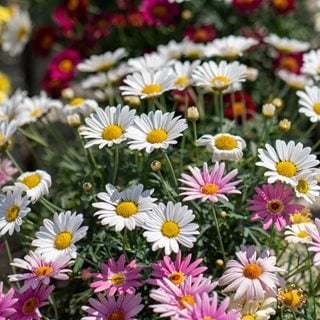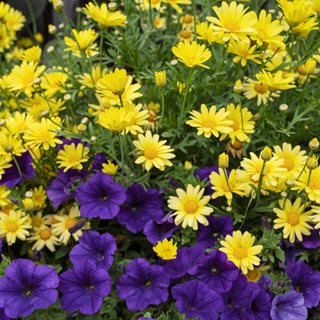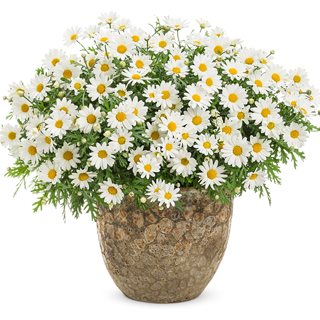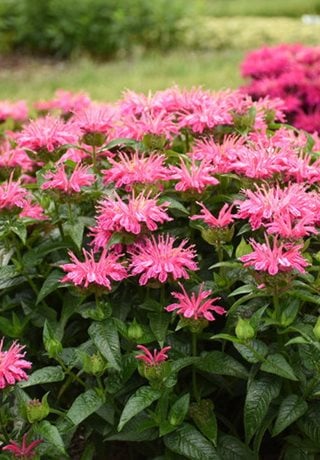HOW TO GROW & CARE FOR MARGUERITE DAISY
This colorful flowering plant makes a versatile addition to beds, borders, and containers
Photo: Paul and Studio / Shutterstock
Marguerite daisy (Argyranthemum spp.) is a flowering ornamental plant with petite blooms that look similar to the more familiar Shasta daisy flowers. This tender perennial has a shrubby habit and ferny foliage that lends structure and fine texture to the landscape, even when plants are not in bloom. Native to the Canary Islands, marguerite daisy is named for the French word for daisy.
Marguerite daisy is versatile in the landscape, adding long-lasting color to flower beds, borders, and containers. The prolific flowers are attractive to butterflies, bees, and other insect pollinators. When given the right growing conditions, marguerite daisy will reward you with lots of beautiful flowers with very little effort. Here’s more on how to grow, use and plant marguerite daisy in your yard.
On this page: Basics | Planting | Care | Pictures | Frequently Asked Questions | Landscaping Ideas
On this page:
- BASICS
- HOW TO PLANT MARGUERITE DAISY
- MARGUERITE DAISY CARE
- MARGUERITE DAISY VARIETIES
- FREQUENTLY ASKED QUESTIONS
- DESIGN IDEAS
MARGUERITE DAISY BASICS
Botanical name:
Argyranthemum frutescens and spp., formerly Chrysanthemum frutescens
Common names:
Marguerite daisy, Canary marguerite, cobbity daisy, marguerite, Paris daisy, summer daisy. Marguerite daisy is not to be confused with blue marguerite daisy (Felicia amelloides) or cape marguerite daisy (Osteospermum ecklonis, Dimorphotheca ecklonis).
Plant type:
Short-lived herbaceous perennial, most often grown as an annual
Zones:
10-11
Exposure:
Full sun to light shade
Habit:
Mounding bushy habit
Height/Spread:
1 to 3 feet tall and wide
Bloom time:
Late spring to early summer, with fall rebloom. Plants may bloom continuously throughout summer in areas with milder temperatures.
Flowers:
Small daisy-like flowers 1 to 3 inches wide are comprised of a central disc surrounded by radiating petals. Varieties come in single, semi-double, or double forms, and in shades of yellow, white, pink, rose, or red.
Foliage:
The delicate dark green foliage is finely cut and fern-like, looking attractive even when plants go out of bloom during hotter weather. Leaves are aromatic when bruised.
HOW TO PLANT MARGUERITE DAISY
When to plant:
Marguerite daisy is sensitive to colder weather. Wait until early spring to mid spring when all danger of frost is past and soil has warmed up to plant marguerite daisy.
Where to plant:
Grow marguerite daisy on a site with at least 6 hours of full sun and moderately rich, well-draining soil. Provide protection from afternoon sun in hotter climates.
How to plant:
Loosen soil in the planting area and amend with compost or other rich organic matter. Dig a hole twice as wide and the same depth as the root ball. Remove plant from the nursery container and gently loosen roots if potbound. Place in the hole so the top of the root ball is level with the surrounding soil. Fill in the hole with soil, tamp down gently, and water thoroughly to remove air pockets. Space plants to allow at least 6 inches between other plants at maturity.
MARGUERITE DAISY CARE

Golden Butterfly® Marguerite daisy and Supertunia® Royal Velvet® petunia. Photo: Proven Winners
Temperature and humidity:
Marguerite daisy is cold sensitive to temperatures below 40 degrees F. and flowers best in cooler temperatures of 70 degrees or below. Hotter conditions may cause plants to reduce flowering or go out of bloom completely. Marguerite daisy will resume flowering from late summer into fall when temperatures cool back down. Extreme humidity and poor air circulation may contribute to fungal diseases.
Soil:
Marguerite daisy does best in moderately rich, well-drained soil with a slightly acidic to neutral pH between 6.0 and 7.5. For containers, use a high-quality, all-purpose potting mix that drains well.
Amendments & fertilizer:
At the time of planting, amend soil with rich organic matter to add nutrients and provide good drainage. During the growing season, apply an all-purpose liquid fertilizer once or twice a month according to package instructions.
Watering:
Marguerite daisy prefers moderate moisture. Keep soil evenly moist but not soggy, and don’t allow soil to dry out completely. Avoid overwatering and overhead watering, which may cause root rot and other fungal diseases. Container plants will need more frequent watering than those in the ground. Make sure containers have adequate drainage holes. Stick your finger 1 to 2 inches into the soil. If soil is dry, it’s time to water. Plants will need more frequent watering during prolonged heat or dry spells.
Pruning:
Marguerite daisy has a neat mounding habit and needs little or no pruning. In mid-summer when flowering slows down, plants can be lightly sheared with small scissors or pruners to encourage a bushier habit, more branching and new flower buds. Deadhead spent flowers to encourage more flowers and neaten plant appearance.
Pests and diseases:
When given the right growing conditions, marguerite daisy is free of most pests and diseases. Pests include aphids, leaf miner mites, thrips, and whiteflies, which can be controlled with a gentle spray of water or application of neem oil. Diseases may include crown gall, powdery mildew, mold, or root rot.
MARGUERITE DAISY VARIETIES
FREQUENTLY ASKED QUESTIONS
Are marguerite daisies deer resistant?
Marguerite daisy is generally deer resistant, though deer will graze on almost any plant if they are hungry enough.
Are marguerite daisies toxic?
Marguerite daisy may be toxic to pets and children if ingested. Contact your doctor, veterinarian or poison control center if you think your pets or children have been affected.
Is a marguerite daisy an annual or perennial?
In frost-free growing zones, marguerite daisy is a short-lived herbaceous perennial. It is most often grown as an annual.
Will marguerite daisies survive winter?
In frost-free growing zones, marguerite daisy can survive through the winter, though plants are short-lived, lasting 2 to 3 years.
Do you deadhead marguerite daisies?
This prolific perennial can be deadheaded to promote new flowers and extend bloom time.
Are marguerite daisies invasive?
Though marguerite daisy may naturalize in frost-free regions where growing conditions are ideal, it’s not considered invasive.
MARGUERITE DAISY LANDSCAPING TIPS

Pure White Butterfly® Marguerite daisy. Photo: Proven Winners
For borders and landscapes:
Use marguerite daisy for quick color in flower beds, borders and mass plantings.
For slopes and hillsides:
Mass marguerite daisy along a slope or hillside as a seasonal erosion control solution.
For containers:
Plant marguerite daisy in a container by itself, or in combination with other plants with similar growing needs.
There are many ways to use Argyranthemum in your landscape. Here’s how:
- Adorn a cottage-style border with marguerite daisies planted alongside other cottage garden plants such as cosmos, dianthus, marigold, nasturtium, phlox, and poppies.
- Include marguerite daisy in a pollinator garden alongside other pollinator-friendly plants such as bee balm, coreopsis, catmint, floss flower, lantana, pentas, salvia, and sweet alyssum.
- Use marguerite daisy at the front of a mixed border to quickly fill in gaps.
- Mass marguerite daisies in a bed as a colorful ground cover.
- Plant a row of marguerite daisies along a pathway for a quick burst of color.
- Plant marguerite daisy in a decorative container by itself or as a “filler” element with other plants with similar growing needs for months of continuous color.
- Adorn a fence line with a row of marguerite daisies for season-long color.
Companion plants: Combine marguerite daisy with other plants with similar growing needs. These include aster, begonia, dianthus, dusty miller, marigold, nasturtium, ornamental grasses, pansies, petunia, phlox, snapdragon, and verbena.
RELATED:
Growing Shasta Daisies
Cottage Garden Design Ideas
More Popular Perennials










